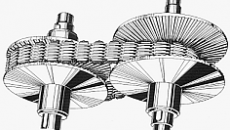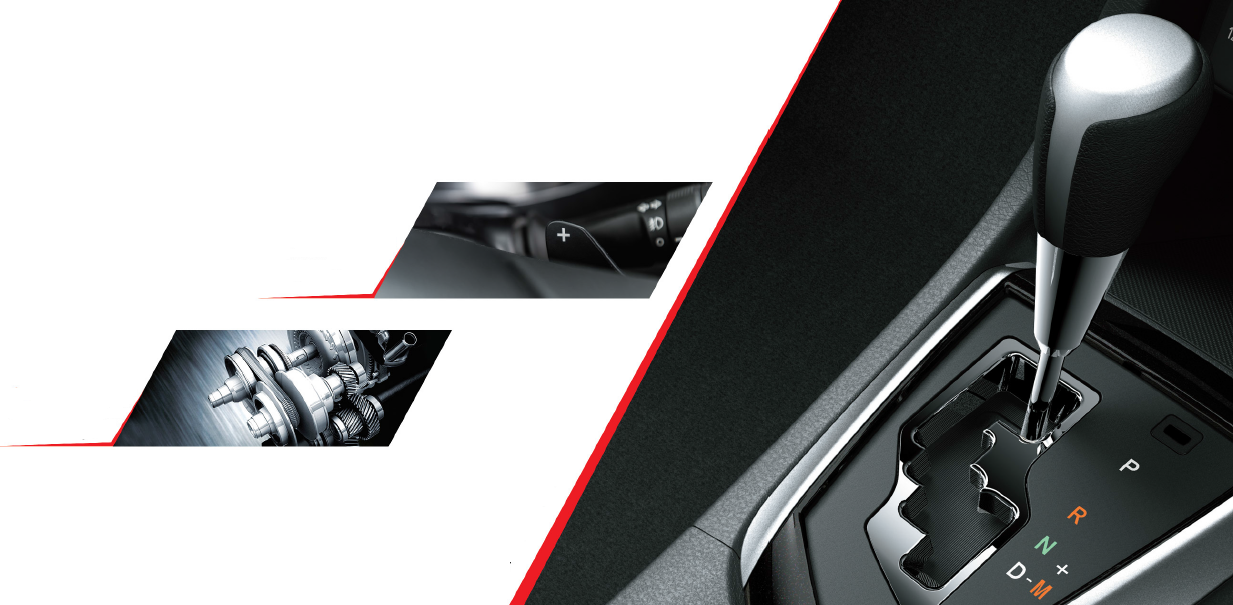Toyota Corolla’s New Transmission : CVT-i
If you are into automobiles then you must have heard of a CVT or may have owned a vehicle with Continuously Variable Transmission. CVT has proved its mettle in the competitive automobile industry and in recent years, we have seen some variety on Pakistani roads as well, including the latest addition to the clan with Corolla Altis’s “CVT-i”.
Before dissecting Toyota Corolla’s transmission, let us throw a brief light on the ‘CVT’ itself and how does it differ from a conventional transmission. Unlike conventional scheme, vehicles with CVT do not have a gearbox with pre-defined number of ratios, which means they do not have the interlocking tooth wheels. CVT operates on an ingenious two pulley system, one of which is connected to the engine while the other to the drive shaft that allows for an infinite variability between highest and lowest gears with no discrete shifts. If you are pondering why the word “gear” still appears in the explanation of a CVT, remember that, generally speaking, a gear refers to a ratio of engine shaft speed to drive shaft speed. Although, CVTs change this ratio without using a set of planetary gears, they are still described as having low and high “gears” for the sake of convention.

Changing the diameter of the pulleys changes the transmission’s ratio in the same way, that a 10-speed mountain bike routes the chain over larger or smaller gears to change the ratio. Making the input pulley smaller and the output pulley larger gives a low ratio (a large number of engine revolutions producing a small number of output revolutions) for a better, low-speed acceleration. As the car accelerates, the pulleys change their diameters to lower the engine speed as car speed rises. This is the same thing a conventional transmission does, but instead of changing the ratio in stages by shifting gears, the CVT continuously varies the ratio – hence the name.
Advantages of the CVT
- Engines do not develop constant power at all speeds; they have specific speeds where torque (pulling power), horsepower (speed power) or fuel efficiency are at their highest levels.
- Because there are no gears to tie a given road speed directly to a given engine speed, the CVT can vary the engine speed as needed to access maximum power, as well as maximum fuel efficiency. This allows the CVT to deliver superior fuel economy.
Disadvantages of the CVT
- The CVT’s biggest problem has been user acceptance. Because the CVT allows the engine to rev at any speed, the noises coming from under the hood sound odd to ears accustomed to conventional manual and automatic transmissions. The gradual changes in engine note sound like a sliding transmission or a slipping clutch – signs of trouble with a conventional transmission, but perfectly normal for a CVT.
- Flooring an automatic car brings a lurch and a sudden burst of power, whereas CVTs provide a smooth, rapid increase to maximum power. To some drivers this makes the car feel slower, when in fact, a CVT will generally out-accelerate an automatic.
Corolla’s 7 step CVT
Automakers have gone to great lengths to make the CVT feel more like a conventional transmission. Many CVTs are programmed to simulate the “kick-down” feel of a regular automatic transmission when the pedal is floored, and some CVTs offer a “manual” mode with steering-wheel-mounted paddle shifters that simulates a conventional stepped transmission which brings us to Pakistani bound Corolla Altis. New Corolla’s transmission is a CVT with pre-programmed 7 ratios. Pre-programming affects the fuel economy and power output at a given RPM, but you get a feel of traditional transmission. Simulated shift points are a smart compromise between the best of both worlds. Ratio changes are still continuous, but the shift points (ratio of the diameter of two pulleys ) are pre-programmed into the vehicle’s engine control unit.
If you are still confused, buzz me in the comment section.
Time Line of the CVT
An Interesting historical time line of a CVT is presented to intrigue the interest of readers:
- 1490 – da Vinci sketches a step-less continuously variable transmission
- 1886 – The first toroidal CVT patent filed
- 1935 – Adiel Dodge receives U.S. patent for toroidal CVT
- 1939 – Fully automatic transmission based on planetary gear system introduced
- 1958 – Daf (of The Netherlands) produces a CVT in a car
- 1989 – Subaru Justy GL is the first U.S.-sold production automobile to offer a CVT
- 2002 – Saturn Vue with a CVT debuts; first Saturn to offer CVT technology
- 2004 – Ford begins offering a CVT


alot confused :D.. good article umair
Which one is better cvt or prosmetic?
What is confusing you ? CVT is two pulleys with a belt between them while conventional auto is a interlocking tooth wheels with 4,5 or 6 ratios
Prosmatec is just a fancy name for the automatic transmission while CVT is a different technology all together.
Both have their pros and cons. People are more accustomed to conventional transmission. CVT is catching up gradually with the improvement in technology
Honda City-Vario (2004-2008) was also CVT, but Honda discontinued CVT from 2009….. why ?
They couldn’t sell it . it was a era when CNG was on a boom in Pakistan. CVT was a ghost transmission back then
You have not mentioned the biggest disadvantages of CVT:
1) It is less durable than an automatic transmission and slight rough use over a
period of time can lead to its failure. Given its design mechanism its
oil heats up rapidly while accelerating and while taking the foot off
the accelerator to let it slow down itself (coasting) and frequently
driving it in such manner can lead to its malfunction. Also they are
less tolerant to fluctuations in power produced by engines as compared
to regular ATs.
2) its oil needs to be changed more frequently (and maybe be expensive too).
3)
the CVT gearboxes often loose their calibration with the power supplied
by the engine at the time of putting it into gear and quite often start
giving jerks when the car is put into gear.
4) while the superior
ratios of CVTs plus other factors contributing to less mechanical losses
as compared to those of regular ATs lead to fuel saving, the saving
reverses in favour of regular AT vehicles when the vehicles are allowed
to decelerate without applying break. In case of CVT vehicles the engine
is continuously supplying power to the wheels while accelerating,
decelerating or moving at constant speed, whereas in case of regular AT
vehicles the supply to the wheel is cut off when the foot is taken off
the accelerator. And this happens quite frequently during driving.
Therefore CVT vehicles are practically fuel efficient as vehicles with
regular ATs.
5) newer ATs have really smooth gear changes and are as pleasant as CVTs.
I think Honda makes performance oriented designs and have made their CVTs as such but they have not succeeded in refining their designs or making them more reliable. And meanwhile have refined the designs or regular automatic transmissions.
Honda keeps minimum margin of failures in its designs, one would say. its transmissions are not as durable than many other manufacturers. if you study and compare the designs of similar vehicles of toyota and honda you ll find that the ones by Honda have smaller oil sumps, less accessible filters etc. performance wise both are equally good or some would say honda’s are better.
Except for Honda and Toyota majority of Japanese automobile makers and even BMW source their transmission from other companies, quite notable is JATCO (Japanese Automatic Transmission Company). While CVTs of Toyota and JATCO have been a success, Honda’s designs have not been as successful or you can say just in case of city vario (being an owner of Honda city vario i think so).
anyhow with the CNG CVTs are more likeable to fail because of vibrations (probably) and less power output of the engines at any certain rpm and require completely different programming of the transmission / or change in its inputs to function with CNG. These factors are not known to common people and therefore CVTs are considered a failure.
its not known to many people but in America Honda CIvic Reborn was offered with a CVT and version with a factory fitted CNG fuel system. No recalls have been heard of that product….
To be more precise prosmatec (progressive gear shift management) is a
gear changing electronic control mechanism of the transmission by Honda in their
transmissions which have made the improved the gear changing mechanism
over the non-prosmatec transmissions.
Million dollar question: given the transmission losses in power between with any kind of an automatic transmission as compared with manual transmission why don’t the automobile engineers concentrate their energies in designing an electro-mechanical control that would riding atop a normal manual transmission and change the gears just like a human hand would while sensing the gear change requirement.
Current generation of CIVIC US version has CVT.
Your insight is interesting. Can you refer me to some text , authentic link which states that modem CVT that we have today needs more maintenance ?
I have bought this cvti a/t recently. its a compltely new experience. the transmission is unbeliveably smooth. P.S. i hav driven many a/t including a4 but this car is very very good.
First of all you happen to be an engineer, i don’t know if a mechanical one. Can’t you visualize which one is more tough?? One consisting of gears or the one with thin inextendable chain of small elements that is able to roll over pulleys of varying diameter and subjected to load in the most unusual way (just from the sides). Imagine the forces in play. And compare them with that of a regular AT where the physical link between the engine and the wheels consist of a pressurised fluid.
From the manuals you can check the drain intervals of oils. For problems turn to pakwheels forums.
Excellent point. But I think CVTs are more fuel efficient, if the gas pedal isn’t floored. Toyota and Lexus, both prefer it over AT in their hybrids. Please correct me if I’m wrong.
True that the cvt transmissions have less mech losses and the constant rpm that engine maintains conserve fuel to a vast degree. But there is a third factor that saves a great deal of fuel that is eliminated with Cvti trans: the ability to ‘coast’. Read my other comment for details.
Hi, does the toyota cvt-i have a clutch plate?
Just like rest of Pak wheels blogs. Nothing but disappointment. You being engineer may write better than those corporate sector people
.
PakWeels Please Tell us The Difference Between Honda CVT and Toyota Super CVT-i
So it means we shouldn’t buy a CVT Transmission equipped vehicle? I recently booked an Altis 1.8 CVT-i Cruisetronic. But after reading this and some other articles I think I have made a mistake. Should have opted for conventional 4-speed Automatic (Altis 1.6). By the way Civic X is also equipped with CVT trans. So why do these high-end locally manufactured sedans opt for CVT?
Plagiarised article.
Sir kindly tell me that is there any need to shift gears in CVT-i on mountains. I mean there are other gears as well other than D